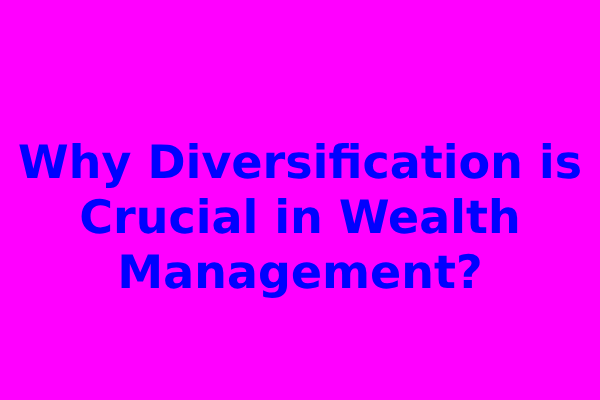Introduction:
In this article, I’ll delve into the paramount importance of diversification in the realm of wealth management. Wealth management is not merely about accumulating assets; it’s about safeguarding and optimizing one’s financial well-being over the long term. Diversification, a fundamental strategy, plays a pivotal role in achieving this goal. This strategic approach entails spreading investments across a variety of asset classes, such as stocks, bonds, real estate, and more, to mitigate risk and enhance potential returns.
Why is diversification crucial, you may wonder? The answer lies in the age-old adage: “Don’t put all your eggs in one basket.” By diversifying your portfolio, you reduce the vulnerability to market fluctuations and unforeseen economic events, thereby preserving your wealth and promoting sustainable growth. In this article, we will explore the reasons, benefits, and best practices associated with diversification in wealth management, empowering you to make informed and secure financial decisions.
Because diversification spreads risk:
Diversification is a foundational principle in wealth management, primarily because it effectively spreads risk across a range of investments. When you invest all your funds in a single asset class or market sector, you become highly susceptible to the performance of that specific asset. If it experiences a downturn, your entire investment is at risk. However, diversification involves allocating your resources across various asset classes, such as stocks, bonds, real estate, and commodities. By doing so, you create a portfolio that is not solely dependent on the performance of one investment. As a result, the risk associated with your portfolio is distributed, lowering the chances of catastrophic losses.
One can liken this strategy to the old adage, “Don’t put all your eggs in one basket.” In financial terms, this means not concentrating all your investments in a single stock or sector. By diversifying, you ensure that even if one asset underperforms or faces adverse market conditions, other investments in your portfolio may compensate for those losses. This spreading of risk minimizes the vulnerability of your overall wealth, creating a more stable financial foundation.
Moreover, diversification is not limited to asset classes; it can extend to geographic regions, industries, and investment instruments. The underlying principle is the same: by avoiding overreliance on any single investment or sector, diversification helps to protect your wealth and promote financial resilience.
Because it minimizes potential losses:
A fundamental advantage of diversification in wealth management is its ability to minimize potential losses. When your investments are concentrated in a single asset class or sector, the fate of your wealth is inextricably linked to that investment’s performance. If the investment encounters a downturn or faces unfavorable market conditions, your losses can be substantial. However, by diversifying your portfolio, you spread your exposure to different assets, each with its own risk and return profile.
Consider a scenario where an investor allocates all their capital to the stock market. In a market downturn, their portfolio’s value would experience a significant decline. On the contrary, if the same investor had diversified their holdings by also investing in bonds, real estate, and other asset classes, the impact of a stock market decline would be less severe. This reduction in potential losses is a key rationale behind diversification.
Diversifying investments is akin to building a financial safety net. It ensures that you are not overly reliant on a single asset or investment type, reducing the impact of adverse events on your overall wealth. This risk reduction makes diversification an essential strategy for long-term financial security.
Because it enhances long-term stability:
Diversification plays a pivotal role in enhancing long-term financial stability. In the world of wealth management, the emphasis is not just on accumulating assets, but on preserving and growing them over time. To achieve this, it is essential to have a stable and robust investment portfolio that can withstand the test of time.
By spreading investments across different asset classes, diversification helps create a resilient and stable investment portfolio. This stability is particularly crucial for individuals with long-term financial goals, such as saving for retirement or funding a child’s education. When you invest in a diversified portfolio, the inherent fluctuations and risks associated with individual assets or sectors are balanced out by the performance of other investments. As a result, your overall portfolio is less susceptible to extreme swings in value and is better equipped to endure various market conditions.
One of the key drivers of long-term stability is the potential for compound returns. Diversified portfolios have historically shown the ability to generate consistent returns over extended periods, enabling investors to benefit from the compounding effect. This compounding can significantly boost the growth of your wealth over time. Diversification is, therefore, an indispensable strategy for those looking to achieve financial stability and sustainability throughout their lifetime.
Because it hedges against market volatility:
Diversification is a potent hedge against market volatility, providing a crucial safeguard for investors in a world where financial markets are inherently unpredictable. Market volatility refers to the extent of price fluctuations in various assets, and it can be influenced by a multitude of factors, including economic data, geopolitical events, and investor sentiment. To navigate the complex and ever-changing landscape of financial markets, diversification is a vital strategy.
When your investments are concentrated in a single asset or asset class, you become highly vulnerable to the performance of that specific investment. If it experiences extreme volatility or a sudden decline, your wealth could be seriously compromised. However, by diversifying your portfolio across different assets, you mitigate the impact of market volatility on your overall wealth.
Diversification acts as a risk management tool by ensuring that no single asset or asset class has an outsized influence on your portfolio’s performance. This means that even if some of your investments experience high volatility or losses, others may remain stable or even appreciate in value. The net effect is that your portfolio’s overall volatility is reduced, making it more resilient and better equipped to weather market fluctuations.
In times of heightened market uncertainty or turbulence, the benefits of diversification become particularly evident. A diversified portfolio can help shield your wealth from the extreme price swings and abrupt market shifts that can be challenging to predict or control. It serves as a hedge that reduces the overall impact of market volatility on your financial well-being.
Because it improves risk-adjusted returns:
Diversification is not only about risk reduction but also about enhancing the risk-adjusted returns of your portfolio. The risk-adjusted return is a measure of how well an investment or portfolio performs in relation to the level of risk it carries. In essence, it evaluates the efficiency of your investments in generating returns while considering the associated risks.
When you diversify your investments, you create a portfolio that combines assets with varying risk levels. Some assets may be more volatile but offer the potential for higher returns, while others are more stable but yield lower returns. The key is to strike a balance that optimizes your portfolio’s risk-adjusted return.
By allocating your resources across different asset classes, you can aim for a portfolio that offers the right mix of risk and return to match your financial goals and risk tolerance. Diversification allows you to tap into the growth potential of riskier assets while maintaining stability through more conservative investments. This balancing act leads to an improved risk-adjusted return, which is essential for long-term financial success.
Investors who focus solely on high-risk, high-reward assets may achieve significant returns during bull markets, but they are also exposed to substantial losses during market downturns. Diversification allows you to benefit from the return potential of various asset classes while simultaneously managing risk. This balance is the essence of optimizing your risk-adjusted returns and achieving a more efficient and effective wealth management strategy.
Because it offers protection in downturns:
A crucial aspect of wealth management is the ability to protect your investments during market downturns and economic recessions. Diversification serves as a shield against these challenging periods, providing a level of protection for your wealth.
During a market downturn or recession, the performance of many investments can be adversely affected. Stocks may experience sharp declines, bonds may offer lower yields, and real estate values may stagnate. However, by diversifying your portfolio, you are less exposed to the full brunt of these downturns. When one asset class is underperforming, others may remain stable or perform better, effectively cushioning the impact of economic hardships on your wealth.
Consider the global financial crisis of 2008 as an example. Investors who had diversified portfolios that included bonds, real estate, and other asset classes were better insulated from the severe losses experienced in the stock market. This diversification offered protection and reduced the financial stress and anxiety often associated with market downturns.
Moreover, diversification also provides you with the flexibility to rebalance your portfolio during downturns. When one asset class is undervalued due to a market slump, you can reallocate your resources to take advantage of buying opportunities. This proactive approach can further enhance your portfolio’s protection during economic hardships.
Because it ensures financial security:
Ensuring financial security is a paramount objective in wealth management, and diversification is a linchpin in achieving this goal. When you entrust your financial well-being to a single investment or asset class, you are essentially placing all your financial security in one basket. Any adverse event, whether it’s a market crash, a corporate bankruptcy, or economic turmoil, can have a devastating impact on your wealth and financial security.
Diversification offers a protective layer that helps safeguard your financial security. By spreading your investments across various assets and asset classes, you reduce the dependency on any one investment for your financial stability. This multi-faceted approach diversifies your sources of income and wealth, making your financial security less vulnerable to unexpected shocks.
Additionally, diversification can serve as an insurance policy against unforeseen events. In the event of a significant loss in one part of your portfolio, the other investments can potentially compensate for these losses. This safety net ensures that your overall financial security is maintained, even when faced with adverse circumstances.
Diversification is, therefore, not just a strategy for enhancing returns or managing risk; it is a fundamental component of securing your financial future and protecting your financial well-being over the long term.
Because it aligns with investment goals:
Every investor has unique financial objectives and goals, whether it’s saving for retirement, funding a child’s education, purchasing a home, or achieving financial independence. Diversification is a strategy that can be customized to align with these specific investment goals.
The beauty of diversification is that it is highly flexible and can be tailored to meet your individual requirements. Depending on your investment horizon, risk tolerance, and financial goals, you can create a diversified portfolio that is perfectly aligned with what you want to achieve.
For instance, if you have a long-term investment goal, such as retirement planning, you can include a mix of assets that balance growth potential with stability to ensure your wealth grows steadily over time. Conversely, if you have a shorter investment horizon and need to preserve capital, your diversified portfolio can prioritize asset classes with lower volatility and income-generating characteristics.
Diversification also accommodates specific preferences and ethical considerations. Some investors may choose to invest in socially responsible or sustainable assets, aligning their portfolios with their values and beliefs. In this way, diversification can be a versatile strategy that caters to your financial aspirations while allowing you to stay true to your investment principles.
Conclusion:
I hope this exploration of why diversification is crucial in wealth management has shed light on the fundamental role it plays in shaping a secure financial future. Diversification is not a mere strategy; it’s a comprehensive approach to managing risk, optimizing returns, and aligning investments with individual goals.
In a world of financial uncertainty and market volatility, diversification acts as a shield, spreading risk and minimizing potential losses. It fosters long-term stability by allowing investors to weather market fluctuations and enhances risk-adjusted returns, ensuring efficient wealth growth. Furthermore, diversification offers protection during economic downturns, reinforcing financial security when it’s needed most.
Ultimately, this strategy aligns with specific investment aspirations, enabling investors to customize their portfolios in harmony with their unique goals and principles. By embracing diversification, individuals can fortify their financial foundations and journey toward enduring prosperity, backed by the wisdom of a well-balanced and resilient investment portfolio.


